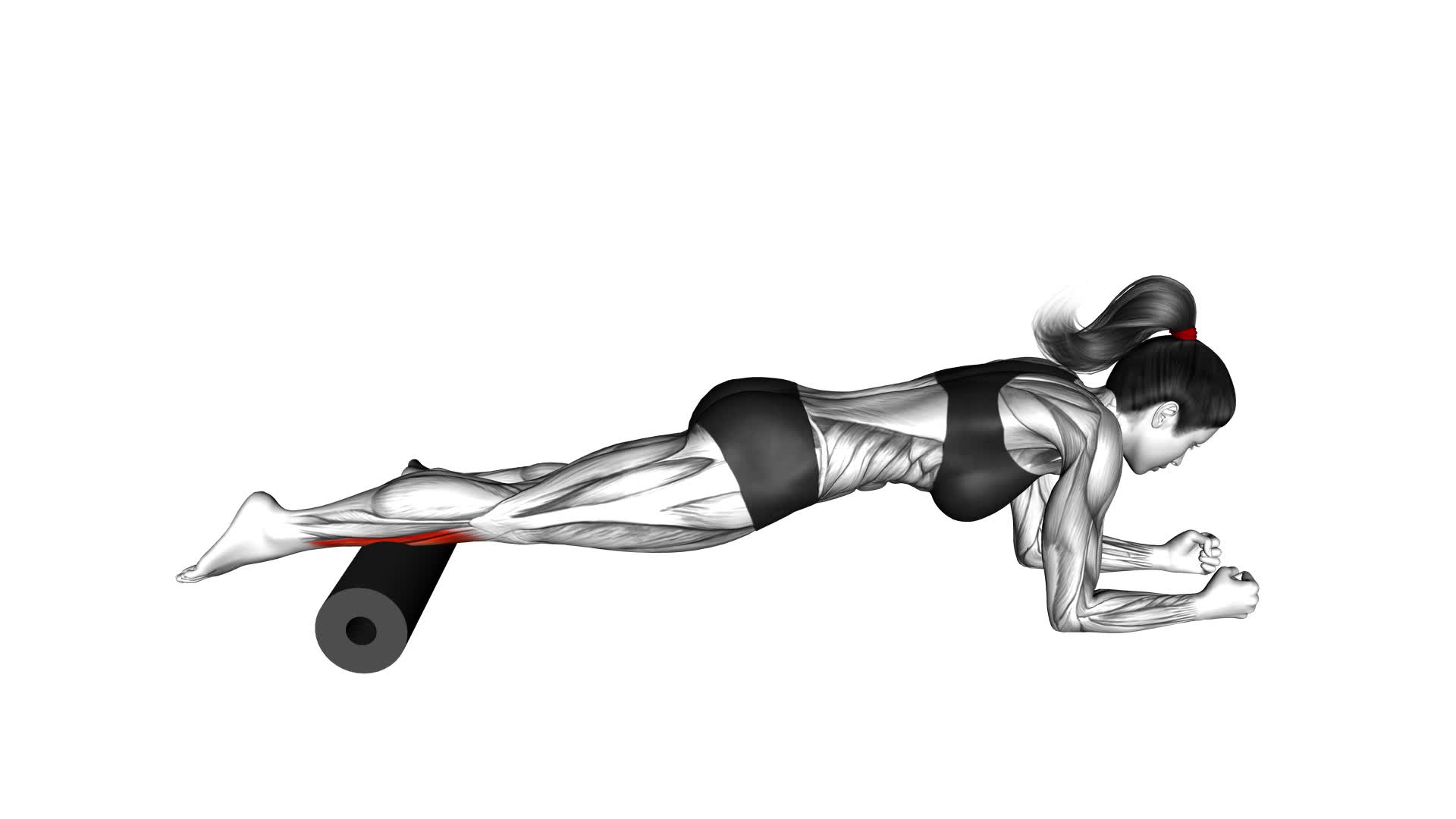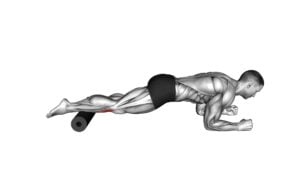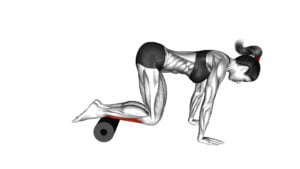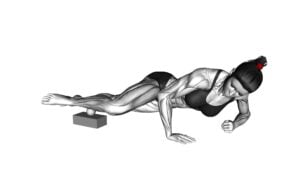Roll Tibialis Anterior (Single Leg) Lying on Floor (female) – Video Exercise Guide & Tips

Are you looking to strengthen your tibialis anterior muscle and improve ankle stability?
Watch This Exercise Video
In this video exercise guide, we'll walk you through the Roll Tibialis Anterior (Single Leg) Lying on Floor, specifically designed for females.
By following proper form and technique, you can reap the benefits of this exercise, such as improved balance and reduced risk of ankle injuries.
Whether you're a beginner or advanced, we've got modifications to suit your fitness level.
Get ready to maximize the effectiveness of your workout with these helpful tips.
Key Takeaways
- The Roll Tibialis Anterior exercise improves ankle mobility and strengthens the tibialis anterior muscles.
- It plays a crucial role in ankle dorsiflexion, enhances lower leg function, and provides stability to the ankle joint.
- This exercise helps reduce the risk of sprains and strains and prevents lower leg injuries during physical activities.
- Proper form and technique, variations, modifications for beginners and advanced levels should be considered for a safe and effective workout.
Benefits of the Roll Tibialis Anterior Exercise
You'll experience improved ankle mobility and strengthened tibialis anterior muscles with the Roll Tibialis Anterior exercise. This exercise is highly effective in activating the muscles in your lower leg, specifically the tibialis anterior. By using a foam roller to massage and apply pressure to this muscle, you can enhance its strength and flexibility.
One of the major benefits of the Roll Tibialis Anterior exercise is its ability to activate the tibialis anterior muscle. This muscle plays a crucial role in ankle dorsiflexion, which is the movement that allows you to lift your toes towards your shin. By targeting and strengthening the tibialis anterior, you can improve your ankle mobility and overall lower leg function.
In addition to muscle activation, the Roll Tibialis Anterior exercise also helps in injury prevention. Strong and flexible tibialis anterior muscles can provide stability to your ankle joint, reducing the risk of sprains and strains. By regularly incorporating this exercise into your routine, you can help prevent common lower leg injuries that may occur during physical activities such as running, jumping, or playing sports.
Proper Form and Technique
To perform the Roll Tibialis Anterior exercise with proper form and technique, start by lying on the floor and positioning yourself in a single leg position. Place the foam roller perpendicular to your shin, just below your knee. Ensure that your ankle and foot are relaxed and not in contact with the roller.
Begin the movement by applying pressure on the roller with your shin and slowly roll it up towards your knee. Pause for a moment when you feel a tender spot or tension in your shin. Then, slowly roll the roller back down towards your ankle. Repeat this rolling motion for the desired number of repetitions.
It is important to maintain proper form and technique throughout the exercise to maximize its effectiveness and prevent injury. Common errors include using too much pressure on the roller, which can cause discomfort or pain. It's also important to avoid rolling too quickly or forcefully, as this can lead to excessive strain on the tibialis anterior muscle.
Variations of the Roll Tibialis Anterior exercise can be done by using a lacrosse ball or a massage stick instead of a foam roller. These variations can provide a deeper massage and target specific areas of tension.
Remember to listen to your body and adjust the intensity of the exercise accordingly. If you experience any pain or discomfort, stop the exercise and consult with a healthcare professional.
Modifications for Beginners and Advanced Levels
Beginners and advanced individuals can modify the Roll Tibialis Anterior exercise to suit their fitness levels and goals. Whether you're just starting out or looking for an extra challenge, here are some modifications you can try:
- Beginner modifications:
- Start by performing the exercise with both legs instead of one. This will provide more stability and help you build strength gradually.
- Use a softer surface, such as a mat or towel, to cushion your knees and make the exercise more comfortable.
- Place your hands on the floor for added support and balance.
- Perform the exercise at a slower pace to focus on proper form and technique.
- Advanced modifications:
- Elevate your upper body by propping yourself up on your elbows or using a stability ball. This will increase the intensity and engage your core muscles.
- Add resistance by using ankle weights or resistance bands around your ankles.
- Increase the range of motion by rolling your foot further towards your body, challenging the muscles even more.
- Perform the exercise on an unstable surface, such as a balance board or foam pad, to further enhance your balance and stability.
Common Mistakes to Avoid
To avoid common mistakes while performing the Roll Tibialis Anterior exercise, focus on maintaining proper form and technique. One of the most common errors is using momentum instead of controlled movements. It's important to remember that this exercise is about targeting and engaging the tibialis anterior muscle, so it's crucial to move slowly and deliberately. Avoid swinging your leg or rushing through the exercise.
Another mistake to watch out for is lifting your hips off the ground. This tends to happen when the exercise becomes too challenging, and you start compensating by using other muscles to assist. To fix this error, concentrate on keeping your hips firmly on the ground throughout the entire movement.
Additionally, be mindful of your foot position. Placing your foot too close or too far away from your body can compromise the effectiveness of the exercise. Make sure your foot is in a comfortable position that allows for proper range of motion.
Finally, avoid overarching your lower back. This can happen when you're not engaging your core properly. To correct this, focus on maintaining a neutral spine by engaging your abdominal muscles and keeping your back flat against the ground.
Tips for Maximizing the Effectiveness of the Exercise
To maximize the effectiveness of the Roll Tibialis Anterior exercise, focus on incorporating progressive overload into your routine. This means gradually increasing the difficulty of the exercise over time. Here are some ways to increase the difficulty and get the most out of your workout:
- Increase the range of motion: Start by rolling the tibialis anterior muscle from the midfoot to the knee. As you progress, gradually increase the distance you roll, extending from the toes to the hip.
- Add resistance: Place a resistance band around your foot or ankle to add resistance as you roll. This will challenge your muscles even more and help build strength.
- Increase frequency and duration: Instead of just performing the exercise once or twice a week, try incorporating it into your routine three to four times a week. Also, gradually increase the duration of each set, starting with 30 seconds and working your way up to one minute or longer.
- Recommended sets and reps: Aim for three to five sets of 10 to 15 rolls per leg. This will provide enough volume to stimulate muscle growth and improve strength.
Frequently Asked Questions
How Many Repetitions of the Roll Tibialis Anterior Exercise Should I Do in One Session?
To determine the number of repetitions for the roll tibialis anterior exercise, consider factors like your fitness level and goals. It's generally recommended to start with 8-12 repetitions per set.
Ensure you maintain proper form throughout the exercise, focusing on a controlled movement.
If you're new to this exercise, it may be beneficial to consult a fitness professional for guidance on proper technique and to customize the number of sets for maximum effectiveness.
Can the Roll Tibialis Anterior Exercise Help With Reducing Shin Splints?
The roll tibialis anterior exercise can be beneficial in reducing shin splints. By strengthening the tibialis anterior muscle, this exercise helps to stabilize the shin and prevent excessive stress on the muscles and tendons.
However, it's important to note that there are also alternative exercises that can be effective in reducing shin splints. These include calf raises, toe taps, and ankle dorsiflexion exercises.
Incorporating a variety of exercises into your routine can help to target different muscles and provide additional benefits.
How Long Does It Typically Take to See Results From Doing the Roll Tibialis Anterior Exercise?
Typically, it takes some time to see results from the roll Tibialis Anterior exercise. The exact duration may vary based on factors like your current fitness level and how frequently you perform the exercise.
However, with consistent practice, you can start experiencing benefits such as improved strength and flexibility in your tibialis anterior muscle.
Remember to stay patient and maintain a regular workout routine to maximize the effectiveness of this exercise.
Is It Necessary to Use Any Equipment or Weights While Performing the Roll Tibialis Anterior Exercise?
It's not necessary to use any equipment or weights while performing the roll tibialis anterior exercise. However, it's important to focus on maintaining proper form throughout the exercise. This will help you target the tibialis anterior muscle effectively and reduce the risk of injury.
Beginners can modify the exercise by starting with smaller movements and gradually increasing the range of motion as they build strength and flexibility. Remember to listen to your body and adjust the exercise to your comfort level.
Are There Any Specific Warm-Up Exercises That Are Recommended Before Doing the Roll Tibialis Anterior Exercise?
Before performing the roll tibialis anterior exercise, it's recommended to do specific warm-up exercises to prepare your muscles and joints. These warm-up exercises can include ankle rotations, calf stretches, and toe taps. They help increase blood flow, improve flexibility, and reduce the risk of injury.
The roll tibialis anterior exercise itself targets the muscles in the front of your shin, helping to strengthen and stabilize the lower leg. Incorporating this exercise into your routine can contribute to better balance and lower body strength.
Conclusion
In conclusion, the roll tibialis anterior exercise is a beneficial way to strengthen the muscles in the front of the lower leg. By maintaining proper form and technique, individuals can effectively target and engage the tibialis anterior muscle.
Beginners and advanced individuals can modify the exercise to match their fitness level. It's important to avoid common mistakes and follow tips to maximize the effectiveness of the exercise.
Incorporating this exercise into a fitness routine can help improve lower leg strength and stability.

Author
Years ago, the spark of my life’s passion ignited in my mind the moment I stepped into the local gym for the first time. The inaugural bead of perspiration, the initial endeavor, the very first surge of endorphins, and a sense of pride that washed over me post-workout marked the beginning of my deep-seated interest in strength sports, fitness, and sports nutrition. This very curiosity blossomed rapidly into a profound fascination, propelling me to earn a Master’s degree in Physical Education from the Academy of Physical Education in Krakow, followed by a Sports Manager diploma from the Jagiellonian University. My journey of growth led me to gain more specialized qualifications, such as being a certified personal trainer with a focus on sports dietetics, a lifeguard, and an instructor for wellness and corrective gymnastics. Theoretical knowledge paired seamlessly with practical experience, reinforcing my belief that the transformation of individuals under my guidance was also a reflection of my personal growth. This belief holds true even today. Each day, I strive to push the boundaries and explore new realms. These realms gently elevate me to greater heights. The unique combination of passion for my field and the continuous quest for growth fuels my drive to break new ground.







